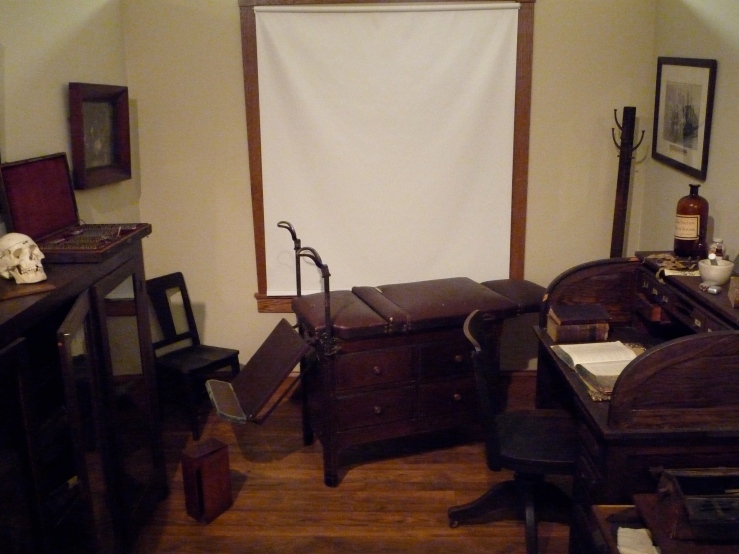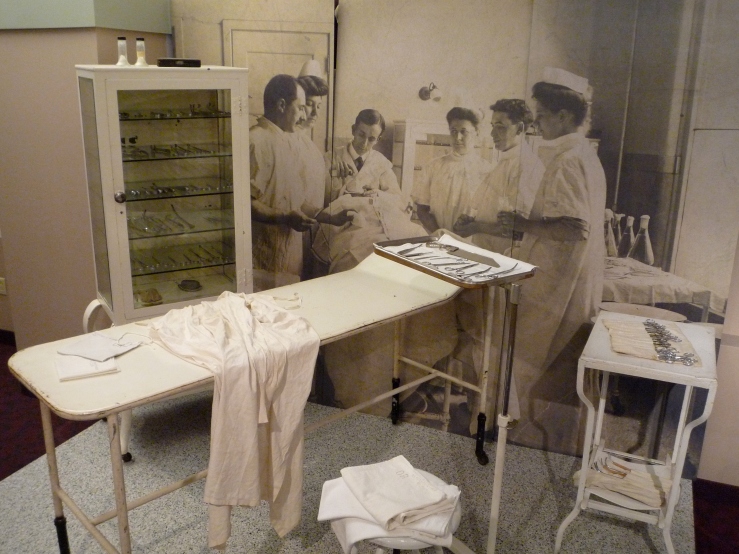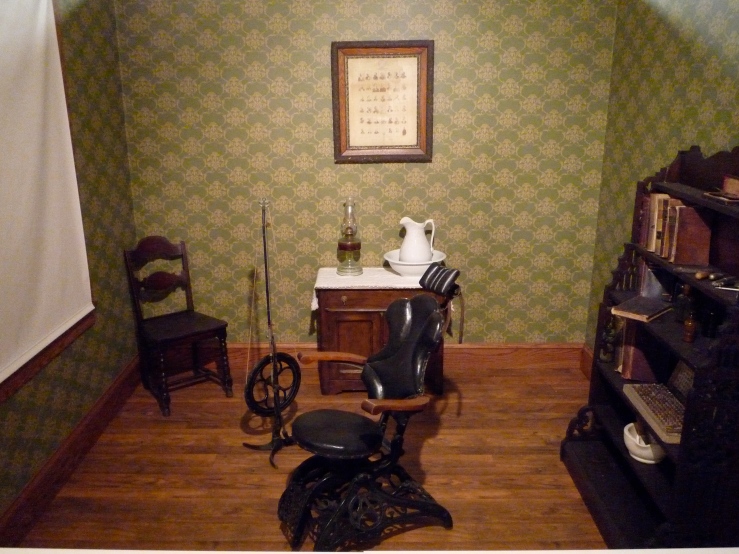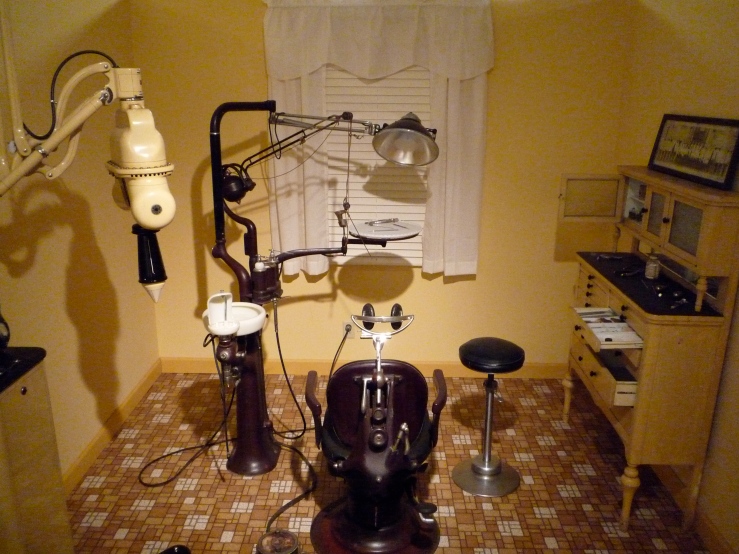
The doctor’s office at the turn of the twentieth century now seems completely unfamiliar to us. The typical physician of our time operates out of a hospital or office complex with a vast array of high-tech equipment. The doctor’s office of the past, however, was quite different. Physicians in the 19th and early 20th century typically operated out of the front room or parlor of their home or had a two-room office (waiting room and examination room) on their property that was detached from the house. In the case of larger cities such as Youngstown, however, doctor’s offices were usually located in the downtown business district, typically on the second floor of a building. While some offices had the waiting room separate from the examination room, it was quite typical to have the two rooms combined, much as you see here. This situation was not practical or efficient and patients often complained about being examined in front of others. The interior of doctor’s offices at the turn of the century was not particularly attractive. They were extremely cluttered and quite simple.
The interior of most offices consisted of an examination table, the doctor’s desk (usually cluttered with books, papers, and bottles), a few chairs for patients to wait, and a spittoon–a necessity in the tobacco chewing days. It was proper and common for the doctor of this period to display his library, microscope, diplomas, pictures of eminent professional friends and teachers, or anything else that was especially associated with their medical studies and career. Although doctors were advised to keep objectionable objects such as skeletons and anatomical specimens hidden from the public eye, many had a human skull or a whole skeleton in plain view because it exhibited their knowledge and interest in anatomy.
To see specific data about the number of doctors in Youngstown, their offices and specialities, see this post.

The doctor’s office of the 1930s was quite different from that at the turn of the century. After 1910, the doctor’s office changed drastically, which is most commonly linked to the result of the practice of asepsis (the prevention of infection by maintaining sterile conditions) and full understanding of the germ theory of disease. Now, it was essential to have an office that could be kept clean and germ free, which is reflected in the appearance of the office. The furniture of the 1930s was typically made of metal with white enamel coating. Other appliances were also white, however, white walls were considered “cold” and “cheerless.” During this period color was believed to have a powerful impact on mental state; therefore, yellows and greens were used most frequently because they were considered the most cheerful and tranquil. Office floors were typically black and white inlaid linoleum with a marbleized effect (as seen here) because it was light and clean.
Whether in a private residence or more commonly in a downtown building, the doctor’s offices of the 1930s were well planned. The new complex consisted of a reception room, private office and consulting room, a dressing room, a business office, rooms for physical therapy treatments, and an examining room (seen here). The contents of the examining room are: stool, examining table, floor lamp, instrument cabinet, scale, sink, and waste receptacle. A specialist’s chair and specialist’s cabinet, used for EENT (eyes, ears, nose, and throat) examinations, testifies to the rise of specialties during this time. Laboratory equipment can be seen on top of the table. Blood and urine tests were more common at this time than in 1905. An electric sterilizer for cleaning instruments also appears, which attests to the new understanding of the germ theory. The anatomical chart takes the place of the skull in the turn-of-the-century office.


This display of an operating room around 1915 contains a metal operating table, stool, instrument stand, and instrument cabinet. The photograph in the background, which shows an operation in progress at the South Unit of Youngstown Hospital at this time, puts the furniture into context and helps the visitor to visualize the reality of surgical practice.
During this time, the operating room lacked the modern conveniences that would be present only ten years later, such as oxygen tanks, anesthesia machines, and electric lights. Although the furniture is metal painted with white enamel, which attests to the rise of the practice of asepsis, the surgeon and assistants do not wear rubber gloves, which indicates that this practice was not widely accepted. Operating procedures still had a long way to go.

During the late 19th century, dentists, like doctors, typically set up shop in the front room or parlor of their homes, as seen here. As the number of professional dentists increased and as cities became more populated, dentists–like their medical counterparts–relocated to cities and established their practice on the second floor of a downtown building. The typical items located in the turn-of-the-century dental office were a chair, cuspidor, wash bowl and basin (or sink depending on the availability of plumbing), and a foot powered dental drill. Although the S. S. White Dental Manufacturing Company marketed the first electric-powered dental drill in 1872, the majority of dentists continued to use the foot driven drill well into the twentieth century because most offices in the country were not electrified. The lack of electricity also resulted in dental chairs being placed in front of a window for a light source.
In the 1800s, most dental offices lacked not only electricity but plumbing as well. Patients rinsed their mouths and spat into an old-fashioned brass bowl that was usually attached to the chair arm. Even when the spittoon was enclosed in an attractive cabinet, it still had to be emptied by hand. The first self-cleaning cuspidor (the Whitcomb Fountain Spittoon), was introduced in 1867, but was not widely used because it required modern plumbing. The reclining dental chair seen here, made by W. D. Allison Company, was one of the first all-metal dentist’s chair. Although German physicist William Conrad Reontgen had developed the X-ray machine in 1895, and Dr. C. Edmund Kells developed it for dental uses shortly thereafter, dentists were very slow in adopting the remarkable new tool. In fact, as late as 1909, only twelve dentists in the United States used X-ray machines, which explains its absence from the office seen here.

This office was quite different from dental offices at the turn of the twentieth century. Like the doctor’s office of the same time period, the choice of color was quite important. Shades of yellows were used on the walls and moldings because of its calming and cheerful effects. Dental equipment had also advanced since the turn of the century. The dental chair in this office, made by the S. S. White Dental Manufacturing Company, is hydraulic. The dental unit (produced by the Ritter Dental Manufacturing Company), which combined many elements in a single piece of equipment–drill, lamp, and cuspidor–marked a great step forward in efficiency. The X-ray machine was also found in just about every dental office since the 1920s. The X-ray machine seen here, patented in 1921 and 1925, was made by the Ritter Company of Rochester, New York and was the newest in design. Also of note is the dentist’s stool. In earlier days dentists stood while working, but in the 1930s dentists sat, as did the dental hygienist.





I have an old 94″ tall door with 4 foot red glass and a hand turn bell on the front. I was told red glass on an office door was a clear indicator of someone in the medical field. Is this true? I’ve been trying to research this information for the past few weeks and can’t seem to find any correlation. I was also told this door is circa late 1880’s-1900 and that gold or copper was used to make the glass red( not a film or laminate, the whole glass pane is red) . Any info would be appreciated!
I have never heard of this, but that doesn’t mean its not true. It could have been a practice that was particular to a certain geographical area or culture. You can try to look for information on this by searching the online Medical Heritage Library: http://www.medicalheritage.org
This is a very interesting site. I’m working on an article about an articulated human skeleton donated to a university for teaching purposes. I’d like to know when and how the practice of articulating human skeletons came into practice, particularly in doctors and dentists offices? So far, my internet searches have turned up little information. Thanks for any help that you can provide.
Hi Connie. Glad our site is helpful. Im not particularly knowledgeable about articulated skeletons as teaching materials. Its much easier to find information about the history of dissection as a teaching method. At any rate, I would place articulated skeletons in the 20th century, as medical care became more of a scientific field and it became socially acceptable for lay people (patients) to see a skeleton. The Dittrick Medical History Center commented about their skeleton in this blog article: https://dittrickmuseumblog.com/2016/03/29/the-people-behind-and-in-the-museum/ Also, from their article, you might try searching for the term “osteological” preparations or specimens.
Thank you so much for this very helpful information.Best, cls
Hi my name is Ashley. My boyfriend and I found this antique gynecologist table in his uncle’s barn yesterday and we’re wondering if you may be able to tell us what year it may have come from and how much it might appraise for. If you could please contact me about this we would greatly appreciate it.
JD ALLISON CO
SERIAL #: 89649
Hi Ashley. I haven’t seen the table, bu I would hesitate to categorize it as a gynecologist table. Many doctors were general practitioners up until the 1930s, so it would not have been unusual for a “regular” doctor to have gynecology equipment, especially in rural areas where doctors were scarce.
I’m not trained to appraise antiques, so I can’t give you a price for the table. I know that its value often depends on the condition of the equipment and if it is missing parts. To date medical equipment, I usually use medical trade catalogs. You might be able to find some online, particularly for a major supplier like JD Allison. One of my previous posts on operating tables might help you get a general idea about the date of your table: https://melnickmedicalmuseum.com/2012/03/14/if-it-aint-broke-dont-fix-it/
[…] of our visitors’ favorite exhibits, the office recreations, can now be seen in downtown Youngstown at the Tyler History […]
[…] The evolution of the doctor’s office. […]
Hi,
I’m trying to find information about the W.D. Allison Co.
I’ve aquired a desk similar to a roll top that rolls sideways that I’m trying to date for age.
Hi Larry.
The W.D. Allison Co was based in Chicago and started around 1893. In 1895, the store was listed as selling physician’s furniture. When I try to date items in the collection, I use old physician instrument catalogs. These would be available at any medical history library or museum in your area. Or you could try talking to a antiques appraiser for a rough date range.
Good luck!
Larry, If you still have this desk, I’ll buy it!
I have an exam table for sale identical to the one pictured above.
I have a w.d.allison dental sergeon chair I would sell its in great condition.
I just purchased a chair that has the WD Allison identity on the back, it is a wood straight back chair, with short arms, leather seat and back, I can’t find it anywhere but the good thing is I paid $1 on a last day of an Estate Sale, very good condition.
Thank you!
I have an 1872 cast iron dentist chair, I believe it is from Dr.Snell/S.S. White. The only mark looks like a foundry mark, 807
That is all. Do you have any resources? I was told it was made in Scotland. Thanks
Best Regards,
Mark Mancano
My suggestion is to locate old dental equipment catalogs. Its difficult to find ones from that early time period of the late 1800s. Some of them have been digitized and are online. If you want it appraised, you’d need to find an antiques dealer who knows something about medical/dental objects.
I have a dental chair manufactured by w d allison that is green, along with the cabinet, that I want to sell. I am trying to find out the value of them…I believe it is from the 1950’s…Any ideas???
I don’t give monetary appraisals. You’ll need to see a medical antiques dealer or appraiser for that. Good luck!
[…] good resource that I found was the Rose Melnick Medical Museum website. They have an article featuring replicas of dentist and doctors offices from 1895-1935. The […]
I have the exact examination table from your 1905 doctors office picture which I received from my father in law’s estate. Could you give me some idea to its monetary value?
I’m glad our photograph was able to help you identify a family artifact. I don’t give monetary appraisals of artifacts. You should contact an appraiser in your area for that information.
This is awesome and really gives you an insight into dental practices over the years.
What a difference 60 years makes!
Thanks
I enjoyed this. I hope you will check out my post on my old office.
drtombibey.wordpress.com
This is a great resource. So glad you’ve added it all to a blog format. I wanted to alert you that the X-ray head showing in the display for the 1935 office dates to the ca. 1950s era. The base looks older however, so possibly the dentist did some updating of the x-ray unit to meet patient and safety demands. Regarding the 1895 Dental Office exhibit: Dr. Edmund Keels last name is really Kells.
I love your website and can’t wait to see your exhibits in person in April when I visit. You’ve got far more information than we do on our exhibits. We are s–l–o–w–l–y working on improving our exhibits. –Shannon O’Dell, Curator; Sindecuse Museum of Dentistry; University of Michigan.